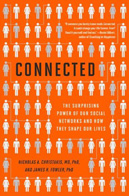Week Ten • Manuel Castells, “Why Networks Matter.” • Connected: The Surprising Power of Out Social Networks and How They Shape our Lives Nicholas Christakis and James Fowler
(posted late… sorry… I was being lazy and waiting for our esteemed professor to publish the Castells’ article, instead of being proactive and searching for it myself.. 😦 but alas, I found it, I think).
Connected reminded me of The Tipping Point by Malcolm Gladwell and I believe reading this book has helped me define my paper topic for the conclusion of the class.
 In Connected, the authors examine the effect of social networks on a variety of occurrences in societies. They look at obesity, loneliness/happiness, smoking/ non-smoking, sexual activity, suicide and other various traits that people in a society possess and how those people are affected by their social network and their position in their network.
In Connected, the authors examine the effect of social networks on a variety of occurrences in societies. They look at obesity, loneliness/happiness, smoking/ non-smoking, sexual activity, suicide and other various traits that people in a society possess and how those people are affected by their social network and their position in their network.
In the first part of the book, they declare five rules to a social network:
- Rule 1: We Shape Our Network
- Rule 2: Our Network Shapes Us
- Rule 3: Our Friends Shape Us
- Rule 4: Our Friends’ Friends’ Friends Shape Us
- Rule 5: The Network Has a Life of Its Own
In addition, they identify two parts of a network – the connections and the contagion. The connections are what binds you to others and the contagion is what travels around the network – whether that is a STD or the emotion of happiness.
The part I was especially interested in is on p. 26, where they discuss Six Degrees of Separation and Three Degrees of Influence. The writers recall Stanley Migram’s experiment that shows that all people are all connected to one another by an average of six degrees of separation.
Miligram’s experiment, conducted in the 1960’s, involved giving a few hundred people who lived in Nebraska a letter addressed to a businessman in Boston, more than a thousand miles away. They were asked to send the letter to somebody they knew personally. The goal was to get it to someone they thought would be more likely than they to have a personal relationship with the Boston businessman. And the number of hops from person to person that the letter took to reach the target was tracked. On average, six hops were required.
I realize that everyone in America is now familar with the Six Degrees of Separation concept but I doubt most understand the social experiment behind it. I am fascinated by the idea and have long been interested in the experiment when I first read about it in The Tipping Point. Now, I also realize that The Tipping Point is more of a mass market, NYT best seller kind of book, and that many more people probably read that book than have read Connected. It seems The Tipping Point however, was published first. (?).
The reason I am interested in this concept is not because everyone is connected to each other, or that I am somehow six degrees separated from someone like Prince William… I am more interested in a concept Gladwell applied to this idea. He mentioned in his work that the social experiment showed something else, (forgive me, but this is from memory… I don’t have the book in front of me….and I read it many years ago). Gladwell said the experiment showed that not only was everyone in the world connected by an average of six degrees but that there were people who held these social networks together. I believe he called them “connectors”. In the experiment, almost all of the hundreds of letters got to the Boston business man through five or six people, ultimately. He claimed that in the social network infrastructure, there were some people who were better connected (had more connections, with better influence that were stronger). These people were actually better at managing their relationships too. They seemed to put more effort into knowing their connections. They cared more about their welfare and had minds that were better equipped at remembering details of their friendships. Joe is married to Martha and they have three kids and one son is on a full ride at an Ivy League university and the two others are girls and they like to figure skate and travel to Italy… etc.
I find this absolutely fascinating. I liked the example of why Hushpuppie Shoes became trendy again in SoHo during the 90’s. Gladwell claimed it was because of these “connectors”. They knew more people. The people they knew found them charismatic and had more equity in their friendship. When they decided something was “cool” so did everyone else in their social circle.
Now to my idea for my paper… I am thinking that I am interested in this course of study for one main reason (currently)… I believe that technology is changing the way the world is fundamentally working… that we are now situated smack-dab in the center of a historical shift in how people relate to each other and their environment. I also believe that because of this huge shift, the rules are now different. I want to focus on how the rules are now different in corporate marketing. I want to investigate the way in which social networks and the revolutionary change in which we now deal with each other, can be exploited for commercial gain. I know it isn’t idealistic or pretty (corporate exploitation is the soft underbelly of our society anyway), but I think it is very interesting and would help me in articulating how the rules are changing for brand equity, public relations and product promotion.

